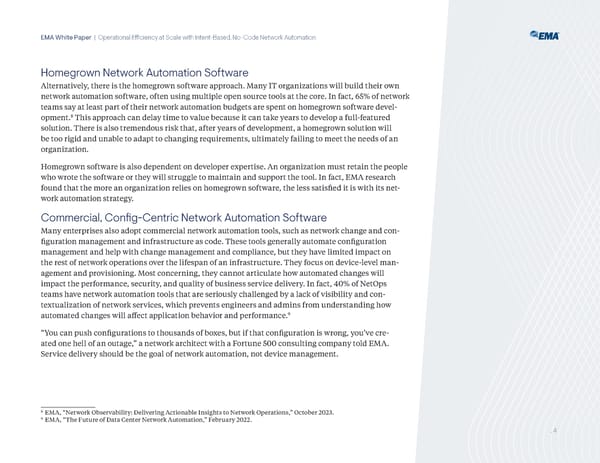EMA White Paper | Operational Efficiency at Scale with Intent-Based, No-Code Network Automation Homegrown Network Automation Software lternatively, there is the homegrown software approach. any IT organi ations will build their own network automation software, often using multiple open source tools at the core. In fact, ¢“‰ of network teams say at least part of their network automation budgets are spent on homegrown software devel- opment.… This approach can delay time to value because it can take years to develop a full-featured solution. There is also tremendous risk that, after years of development, a homegrown solution will be too rigid and unable to adapt to changing reuirements, ultimately failing to meet the needs of an organi ation. ¤omegrown software is also dependent on developer expertise. n organi ation must retain the people who wrote the software or they will struggle to maintain and support the tool. In fact, Š research found that the more an organi ation relies on homegrown software, the less satisfied it is with its net- work automation strategy. Commercial, Config-Centric Network Automation Software any enterprises also adopt commercial network automation tools, such as network change and con- figuration management and infrastructure as code. These tools generally automate configuration management and help with change management and compliance, but they have limited impact on the rest of network operations over the lifespan of an infrastructure. They focus on device-level man- agement and provisioning. ost concerning, they cannot articulate how automated changes will impact the performance, security, and uality of business service delivery. In fact, ‡ƒ‰ of et†ps teams have network automation tools that are seriously challenged by a lack of visibility and con- textuali ation of network services, which prevents engineers and admins from understanding how ™ automated changes will affect application behavior and performance. “›ou can push configurations to thousands of boxes, but if that configuration is wrong, you’ve cre- ated one hell of an outage,” a network architect with a €ortune “ƒƒ consulting company told Š. £ervice delivery should be the goal of network automation, not device management. … Š, “etwork †bservabilityž Ÿelivering ctionable Insights to etwork †perations,” †ctober ‚ƒ‚Ž. ™ Š, “The €uture of Ÿata enter etwork utomation,” €ebruary ‚ƒ‚‚. . 4
 Operational Efficiency at Scale with Intent, No-Code Network Automation Page 5 Page 7
Operational Efficiency at Scale with Intent, No-Code Network Automation Page 5 Page 7